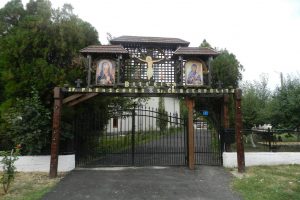

The house on Mihai Eminescu Street no. 44 is one of the oldest buildings in Slatina, being registred in the list of historical monuments of Olt county.
Slatina history can be read on the streets of the city at the end of of the nineteenth century and early twentieth century. The architecture of the houses from those times has influences of classical, neoclassical, art nouveau, neo-Romanian, Brancoveanu style and French eclecticism.
At the beginning of twentieth century the city of Slatina, with the center and slums, had the form of a pentagon with the sides: “Pârliţii, Brebenii,Clocociov Monastery, the barrack from Caloianca hill, and the joining of the brook Valea Muierii with River Olt” among which were outlined the neighborhoods: City center, Obrocarii , Caloianca, Sopot, Station Road, the Clocociov, Dealul Viilor, having 42 streets, some of them having ‘sidewalks paved with basalt on a linear spread of 1580 meters. ”
Between the two world wars, the portion of Bucharest Street from the Public Garden to the Municipal Palace, was named Constantin Dissescu, now called Mihai Eminescu.
C. Dissescu was born in Slatina in 1857, was a great personality of Romania: teacher, eminent jurist – the creator of the discipline of Roman administrative and constitutional law – renowned lawyer, diplomat.
The buildings that make up the historical heritage play the main role in the urban landscape of the old city center. They are located on Lipscani Street and Mihai Eminescu Street, on both sides. In total there are 81 structures, built between 1860 to 1938 in one of the following styles: neo-Gothic, neo-Romanian, modern, art nouveau, art deco and renovation of various periods. Most buildings have at the ground floor, commercial premises and upstairs a residential space.
There are divided opinions about the origin of the name of the town. A first version suggests that the name Slatina is of Slavic origin, derived from the words “slam” (earth) and “tina” (salty); thus the name would translate as “salt land”, “salter food”, “salt water”, referring to the river Olt. This hypothesis appears to be motivated by the Slavic toponymy of some areas within the city and of surroundings, as well as some nearby localities (Obrocari – today Tudor Vladimirescu Street, Hill Grădiştea, Clocociov, Dobrotinet, Milcov, Brebeni, Sopot, Teslui etc.).
Also in favor of this hypothesis come the records of historian A.D. Xenopol, who speaks about the Slavs as migratory population.
A second hypothesis claims that the city’s name comes from the archaic Latin “Salaatina”, “Salatina”, “Slatina” – thus resulting that the city of Slatina bears the name of the Roman colony that once was installed here.


